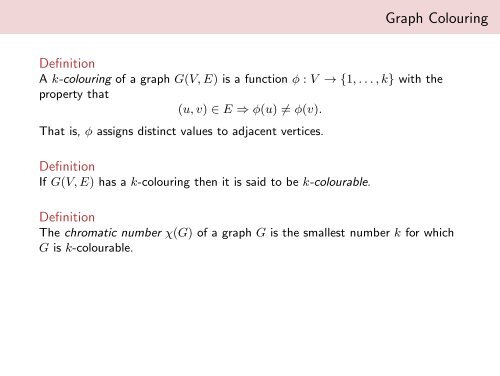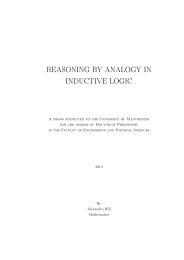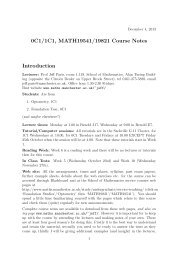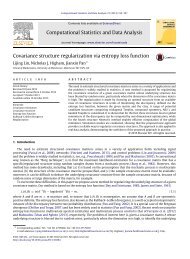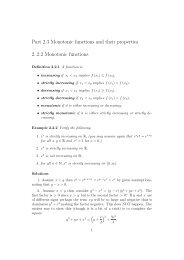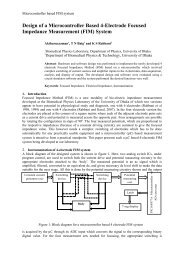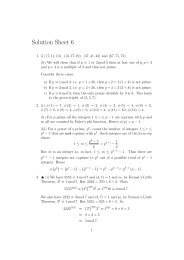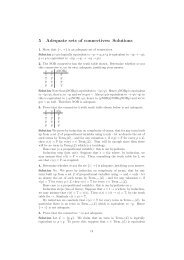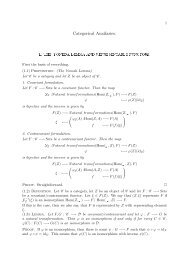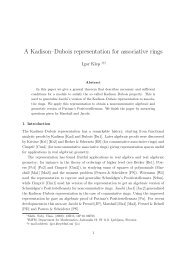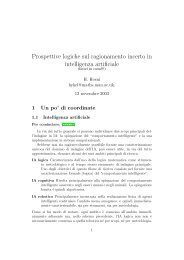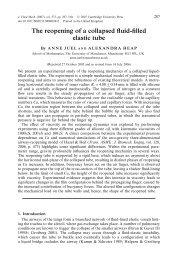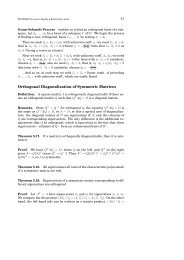Graph Colouring
Graph Colouring
Graph Colouring
Create successful ePaper yourself
Turn your PDF publications into a flip-book with our unique Google optimized e-Paper software.
<strong>Graph</strong> <strong>Colouring</strong><br />
Definition<br />
A k-colouring of a graph G(V,E) is a function φ : V → {1,...,k} with the<br />
property that<br />
(u,v) ∈ E ⇒ φ(u) = φ(v).<br />
That is, φ assigns distinct values to adjacent vertices.<br />
Definition<br />
If G(V,E) has a k-colouring then it is said to be k-colourable.<br />
Definition<br />
The chromatic number χ(G) of a graph G is the smallest number k for which<br />
G is k-colourable.
Examples of graphs and their chromatic numbers include<br />
• Kn, the complete graph on n vertices is clearly n-colourable, but not<br />
(n−1) colourable: thus χ(Kn) = n.<br />
• Km,n, the complete bipartite graph on groups of m and n vertices, is<br />
2-colourable, but not 1-colourable, so χ(Km,n) = 2.<br />
3<br />
1 2 1<br />
4<br />
4<br />
5<br />
3<br />
2<br />
1<br />
2<br />
1<br />
2<br />
1 1 1<br />
2 2 2 2<br />
Examples
Three Handy Results<br />
It is generally a hard problem to compute the chromatic number of a graph,<br />
but the following results help for small graphs.<br />
Lemma (χ(G) for bipartite graphs)<br />
A graph G has chromatic number χ(G) = 2 if and only if it is bipartite.<br />
Lemma (<strong>Colouring</strong> subgraphs)<br />
If H is a subgraph of G and G is k-colourable, then so is H.<br />
Lemma (Chromatic number of subgraphs)<br />
If H is a subgraph of G then χ(H) ≤ χ(G).
Algorithm (Greedy colouring)<br />
Greedy <strong>Colouring</strong> (an algorithm)<br />
Given a graph G(V,E) with vertex set V = {v1,...,vn} and adjacency lists<br />
Av j , construct a function c : V → Z + such that if the edge e = (vi,vj) ∈ E,<br />
then c(vi) = c(vj).<br />
1 Set c(vj) ← 0 for all 1 ≤ j ≤ n.<br />
2 c(v1) ← 1.<br />
3 For 2 ≤ j ≤ n {<br />
4 Choose a colour k > 0 for vertex vj<br />
that differs from its neighbours’ colours<br />
c(vj) ← min <br />
k ∈ Z|k > 0 and c(w) = k ∀w ∈ Avj 5 } End of loop over vertices vj.
The two columns at right show<br />
the result of applying the<br />
greedy colouring algorithm to<br />
two versions of the same<br />
graph.<br />
• The only difference<br />
between the two columns<br />
is that that roles of v4<br />
and v5 have been<br />
interchanged.<br />
• In the leftmost column we<br />
get a three-colouring,<br />
which is minimal for this<br />
graph, while in the<br />
rightmost column we get<br />
a four colouring.<br />
• Generally speaking, greedy<br />
colouring provides only an<br />
upper bound on χ(G).<br />
Greedy <strong>Colouring</strong> Provides Upper Bounds<br />
v1 1<br />
v1 1<br />
v1 1<br />
v 2<br />
v2 2<br />
v2 2<br />
v 3<br />
v 3<br />
3<br />
v3 v2 2<br />
v 4<br />
v 4<br />
v 4<br />
v1 v4 1 1<br />
3<br />
v3 v2 2<br />
v1 v4 v5 1 1 2<br />
3<br />
v3 v 5<br />
v 5<br />
v 5<br />
v 5<br />
v1 1<br />
v1 1<br />
v1 1<br />
v 2<br />
v2 2<br />
v2 2<br />
v 3<br />
v 3<br />
3<br />
v3 v2 2<br />
v1 v5 v4 1 1<br />
3<br />
v3 v2 2<br />
v1 v5 v4 1 4 1<br />
3<br />
v3 v 5<br />
v 5<br />
v 5<br />
v 4<br />
v 4<br />
v 4
Theorem (The Four Colour Theorem)<br />
Four Colours Suffice<br />
Every planar graph G has χ(G) ≤ 4. That is, a planar graph can always be<br />
coloured with four or fewer colours.<br />
The Four Colour Theorem engaged the interest of such famous mathematicians<br />
as Hamilton, De Morgan, Cayley and Birkhoff. It also prompted a famous<br />
incorrect proof that survived from 1879 to 1890. The first correct proof,<br />
produced by Kenneth Appel and Wolfgang Haken in 1977, is also the first and<br />
best-known example of a major problem resolved by means of a computer-aided<br />
proof.
Afterword: <strong>Colouring</strong> Maps<br />
The Four Colour Theorem was originally conjectured in the 1850’s by Francis<br />
Guthrie and it arises from an observation about cartography. Guthrie’s brother<br />
Frederick was thinking about colouring a map in such a way that it was easy to<br />
tell the different countries apart. He wanted to choose colours so that adjacent<br />
countries—those that share a segment of border—receive different colours and<br />
he observed that he never needed more than four colours to accomplish this.


